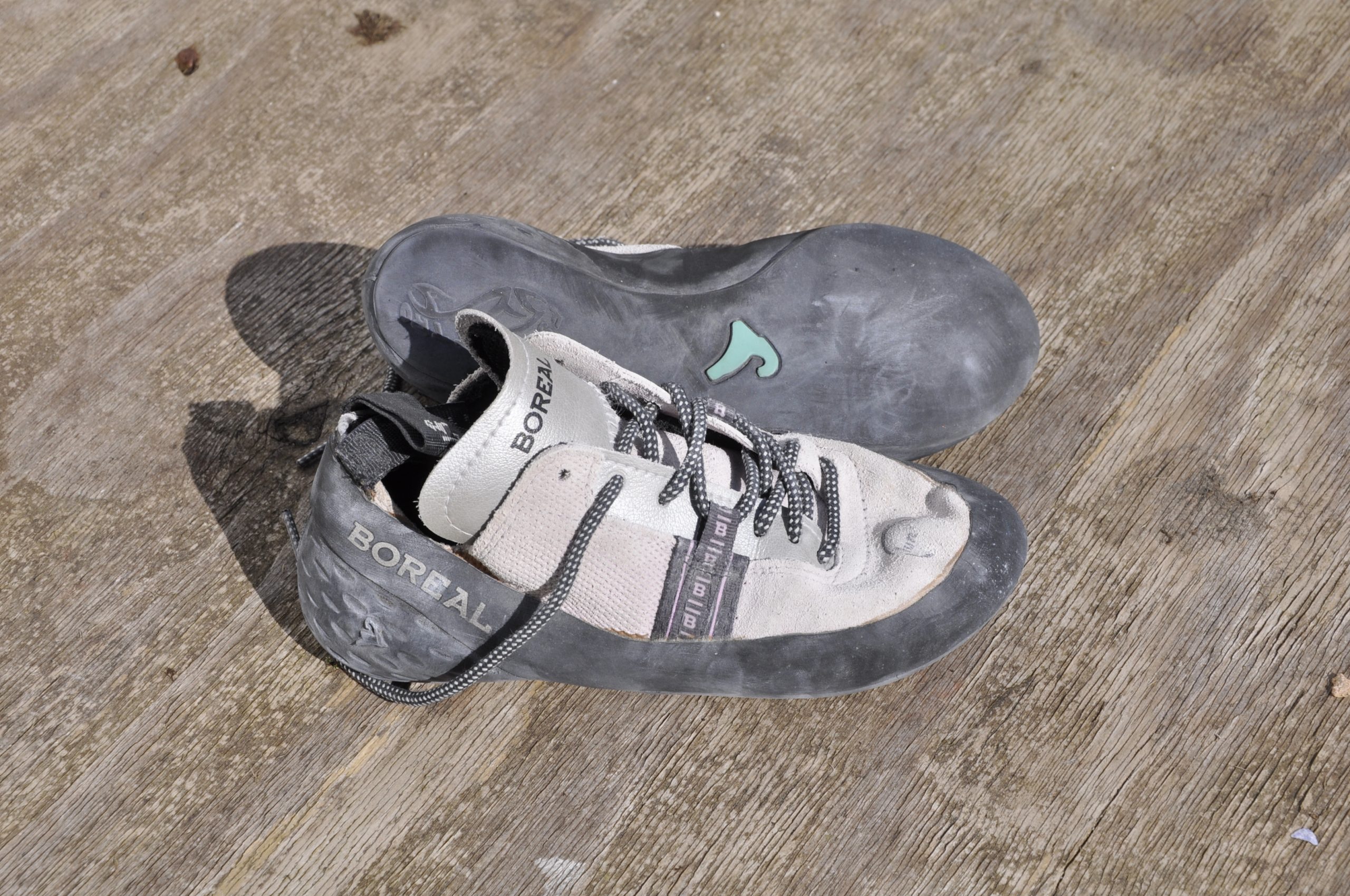
I had no prior knowledge, all I knew was that I wanted a pair that were:
1. Reasonably priced
2. Long-lasting
3. Comfortable
After trying on a few pairs of shoes and chatting to friends, shop assistants and checking out online reviews I opted for a lace up shoe – the Boreal Lunas which came in a girly shade of lilac.
I made the purchase and when I got home I excitedly opened the box and proceeded to endure the torture of wearing in my very fresh pair of climbing shoes around the house. My feet were not happy bunnies, but over time they’ve tolerated the Lunas and now have formed a beautiful and long-lasting friendship.
As far as climbing shoes go the Boreals are really quite comfortable…obviously not comfortable compared to normal shoes, but comfortable when stepping into the realm of climbing footwear.
I would highly recommend the Boreal Lunas as a great shoe for the beginner female climber. They were around £70 new and gave me everything I was after in my first pair of climbing shoes. After a years use they are only just on the verge of needing a resole. They have done me proud, bouldering and climbing indoors 2-3 times a week and heading outdoors on Southern Sandstone and gritstone in the spring and summer.
Women’s feet tend to be narrower, with lower volume and a lot of climbing shoes don’t give a snug fit. The Lunas are designed especially for women and they have always fit me nicely. They have mid shoe lacing eyelets which really help to adjust the tightness of the shoe around the arch and encourage an even snugger fit. Over time climbing shoes tend to stretch a bit which the Lunas have slightly but the laces help and pulled tight they still retain an excellent fit.
The sole of the Lunas is made of Boreal’s FS-Quattro rubber and thickness varies depending on the shoe size (4-4.6mm). I found the thickness of the sole has been a good balance, providing me with enough sensitivity to feel smaller holds and also providing plenty of support.
Summary: Overall the Lunas aren’t the most technical shoe but they are great for beginners and offer comfort and support for those climbing for longer periods of time (ideal for long sport or trad routes.) Laces help to keep the fit snug if the shoe stretches over time and the thin low profile toe of the shoe makes it great for crack climbs. They are reasonably priced and long lasting. I would highly recommend, but of course, everybody’s feet are different so make sure you try a few different shoes and pick something suitable for you.

Guide to Buying your first pair of climbing shoes:
Try before you buy – You can try shoes in shops or if you visit your local climbing wall they may have a selection for you to try out. Make sure you visit a shop with experts on hand to help and with a variety of shoes for you to try. Expert retail staff will also be able to measure your feet and advise on the best size shoe for you.
Fit
Shoes should be snug, not painful but reasonably uncomfortable. If you are a beginner climber you don’t have to get really small shoes! As you advance with your climbing you may find that you start looking at more technical shoes, but these aren’t necessary for the beginner climber as routes will be easier, on balance and with larger holds.
Use
For your first pair of climbing shoes you want an all rounder. In the future as you advance with your climbing you might look at purchasing a few pairs for different things but initially one pair will suffice!
Fastening
Each type of fastening has its plus points. Laces provide more adjustment then other fastenings, but are slow to get on and off. Shoes with Velcro and slippers are easier to take on and off making them better for indoor walls where you may decide to go with a slightly smaller or more technical shoe. Choose which will be best for you and the type of climbing you want to pursue.
Sizing and Stretching
Different brands of shoe can offer variations in sizing. For example, if you are a size 5 in one brands shoe it doesn’t mean that you will be a 5 in another brand. Some shoes will stretch a bit with use and time. The stretch isn’t much but could impact fit. Make sure when you first buy a pair of shoes that you don’t need to pull the fasteners completely tight otherwise there wont be any room for future adjustment. Lined shoes are less likely to stretch as than unlined shoes. A good fit means its nice and snug with no loose areas or pockets of air. Make sure the fit around your ankle is comfortable. Some shoes can dig in because they sit to high on the bone.
Feet
Everyone’s feet are different and shoes vary to suit different needs. Make sure you choose a shoe that is perfect for you, not for one of your mates. What suits them might not be the same thing that you need.
Rubber Soles
A stiff shoe gives support and is better on small positive holds. A soft shoe bends more and is better for smearing and slopey footholds. Stiff shoes provide less sensitivity meaning that you are unable to tell how the hold feels. There are a vast amount of different types of ‘sticky’ rubber on the market, many of which claim to be the ‘stickiest’. While some are definitely better than others its not worth getting to hung up on with your first climbing shoes. Happy shopping and happy climbing!
By Clare Hume


Leave a Reply